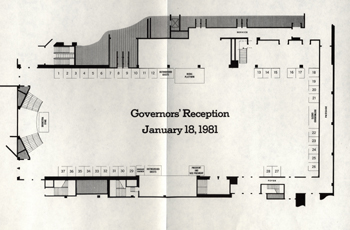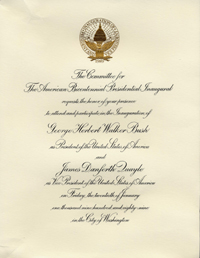January 2005: From Floor Plans to Press Passes -
Organizing an Inauguration

President Jimmy Carter takes the oath of office on January 20, 1977.
[larger
image]
Every four years, on January 20, the President and Vice President of the United States are inaugurated in Washington, DC. The swearing-in ceremony itself is a congressional responsibility. But the many events that surround that ceremony are planned and managed by a Presidential inaugural committee.
Inaugural committees were first recognized in law by a joint congressional resolution in 1881, authorizing the War and Navy Departments to lend logistical support to the Committee on Inaugural Ceremonies, an organization of Washington residents preparing for the inauguration of President-elect James A. Garfield. Federal and District assistance to inaugural committees continued and expanded by joint resolution for each successive inauguration through 1953 and was ultimately made permanent by the Presidential Inaugural Ceremonies Act of 1956.
 |
Press passes such as this one allowed members of
the media to view President John F. Kennedy's inaugural parade from the
grounds of the White House. |
Immediately after an election, the President-elect establishes an inaugural committee. The committee has a little more than two months to organize every aspect of the inauguration other than the swearing-in ceremony. It plans the parade, selects bands, and arranges for the construction of grandstands. It organizes receptions and balls, puts together guest lists, and draws up floor plans and seating charts. It oversees the creation of invitations, tickets, badges, programs, and souvenir items. It plans for press coverage and issues credentials. It maintains liaison with Federal and Washington agencies that provide assistance, and much more.

A reception in honor of the governors of the states was held in the Sheraton Washington Hotel
two days before President Ronald Reagan's first inauguration. This was the floor plan. [larger
image]
These activities generate numerous records. After the inauguration has taken place and the committee has disbanded, the records become part of the holdings of the National Archives—Record Group 274, Records of Presidential Inaugural Committees. Some years later, after the President has left office and a Presidential library has been constructed, the records are housed in the library.

This commemorative medallion was among the souvenirs created for President Richard Nixon's
1973 inauguration. [larger
image]
The records are more than memorabilia; they can provide future inaugural committees with practical guidance about approaching all the complex tasks involved in planning inaugural festivities. For example, the records of the 1989 Inaugural Committee, responsible for planning the inauguration of President George H.W. Bush, reveal that the committee consulted reports, photographs, programs, and seating charts from several previous inaugurations, including those of Presidents Truman, Eisenhower, Kennedy, Johnson, Nixon, Carter, and Reagan.

As the invitation to President George H.W. Bush's inauguration indicates, it was the bicentennial
inaugural - 200 years after George Washington first took the oath of office. [larger
image]
Other records relating to inaugurations are found throughout the National Archives. The 20th amendment to the Constitution, which was ratified in 1933 and which shifted the official inauguration day from March 4 to January 20, is part of Record Group 11, General Records of the United States Government. Photographs of inaugural ceremonies and festivities are found in White House photograph collections and among the records of military branches that participate in these events. Drafts of inaugural addresses may be housed with other personal papers of Presidents.
One special inaugural address, now among the records of the United States Senate, will be on display this month at the National Archives Building. It's the very first such address, handwritten by George Washington and delivered at Federal Hall in New York City on April 30, 1789. See this month's calendar for more details about the display.
With the exception of the photograph of President Carter's inauguration, which is part of the White House Photographs collection at the Carter Library, all images on this page belong to Record Group 274, Records of Presidential Inaugural Committees, and are housed in the appropriate Presidential library or in the Nixon Presidential Materials.
PDF files require the free Adobe Reader.
More information on Adobe Acrobat PDF files is available on our Accessibility page.
